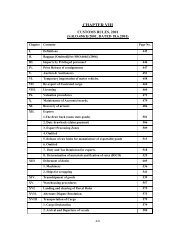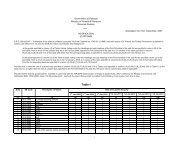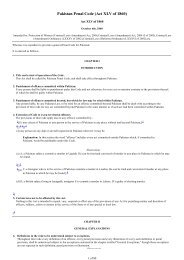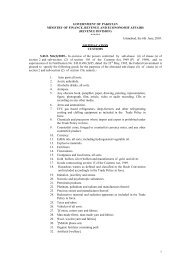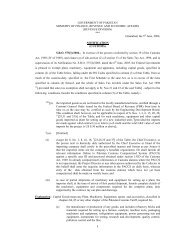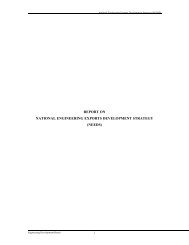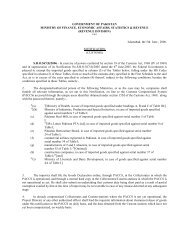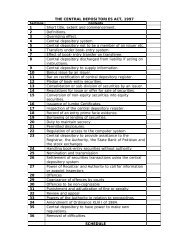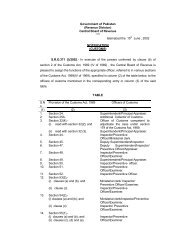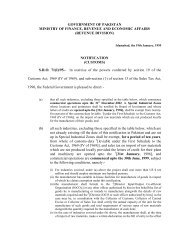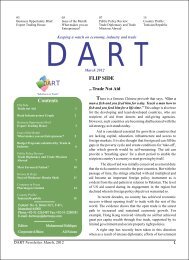47. Pakistan Economic Survey 2011-12 - Consultancy Services in ...
47. Pakistan Economic Survey 2011-12 - Consultancy Services in ...
47. Pakistan Economic Survey 2011-12 - Consultancy Services in ...
Create successful ePaper yourself
Turn your PDF publications into a flip-book with our unique Google optimized e-Paper software.
Chapter 5Money and Credit<strong>Pakistan</strong>’s monetary policy aims at stabiliz<strong>in</strong>geconomic growth through a number of channels. It<strong>in</strong>fluences the future expectations of economicactivity and <strong>in</strong>flation. A sound fiscal position isimportant for achiev<strong>in</strong>g macroeconomic stability.This occurs through efficient resource allocationand the mobilization of domestic sav<strong>in</strong>gs. Becauseof this, the central bank through its monetarypolicy and strategies plays an <strong>in</strong>fluential role.The global f<strong>in</strong>ancial crisis that erupted <strong>in</strong> late 2007not only produced the severe worldwide economiccontraction, it has also hampered the ability ofcentral banks to successfully manage the economy.In reaction to the crisis, markets of developedeconomies responded <strong>in</strong> a variety of ways, such ascreat<strong>in</strong>g measures aimed at specific sectors, as wellas more general stimulus packages aimed atkeep<strong>in</strong>g f<strong>in</strong>ancial <strong>in</strong>stitutions buoyant. On the otherhand, economic activity <strong>in</strong> emerg<strong>in</strong>g anddevelop<strong>in</strong>g economies rema<strong>in</strong>ed relativelyvigorous on account of strong <strong>in</strong>ternal demand.The global economic activity rebounded <strong>in</strong> 2010on the back of better macroeconomic performanceand cont<strong>in</strong>ued accommodative macroeconomicpolicies. Unfortunately, performance slowed later<strong>in</strong> the year because countries with large public andprivate debt burdens faced serious problemsaccess<strong>in</strong>g sovereign debt markets. Consequently,heightened concerns about long term debtsusta<strong>in</strong>ability <strong>in</strong> various parts of the world haveposed additional risks, not only to f<strong>in</strong>ancialstability, but also for the ability to access safeassets.Box 1High Demand for Safe AssetsThere is a potential threat to global f<strong>in</strong>ancial stability due to high demand for safe assets. The threat has been drivenup on account of heightened uncerta<strong>in</strong>ty, regulatory reforms and the extraord<strong>in</strong>ary post-crisis responses of centralbanks <strong>in</strong> the advance economies. The supply of safe assets has contracted as the ability of the public and the privatesectors to produce such assets has decl<strong>in</strong>ed. Similarly, the number of countries whose debt is considered safe hasfallen. Lack of safe asset scarcity will <strong>in</strong>crease the price of safety and compel <strong>in</strong>vestors to move down the safetyscale. It will also lead to more short-term spikes <strong>in</strong> volatility, and shortages of high-grade collateral.There is a need for flexibility <strong>in</strong> policy design and implementation for a smooth adjustment <strong>in</strong> the markets for safeassets. Hence policy makers should strike a balance between the desire to ensure the soundness of f<strong>in</strong>ancial<strong>in</strong>stitutions and the costs associated with potential overly rapid acquisitions of safe assets to meet such goals.Global F<strong>in</strong>ancial Stability Report, April 20<strong>12</strong>. IMF.<strong>Pakistan</strong>’s f<strong>in</strong>ancial sector has not witnessed adirect impact of the global f<strong>in</strong>ancial crisis due to itslimited exposure <strong>in</strong> <strong>in</strong>ternational f<strong>in</strong>ancial markets.However, high <strong>in</strong>flationary pressures, heightenedsecurity risks, power shortages and a high cost ofdo<strong>in</strong>g bus<strong>in</strong>ess posed numerous challenges for<strong>Pakistan</strong>’s economy. Consequently, all thesefactors along with the global f<strong>in</strong>ancial crisis causeda deceleration <strong>in</strong> the <strong>in</strong>vestment rate, a rise <strong>in</strong>65



